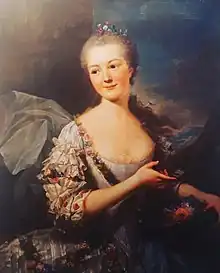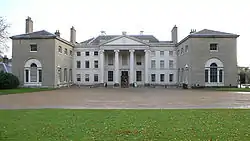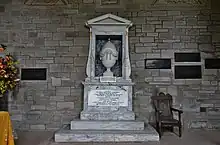David Murray, 2nd Earl of Mansfield
David Murray, 2nd Earl of Mansfield, 7th Viscount of Stormont, KT, PC (9 October 1727 – 1 September 1796), known as the (7th) Viscount of Stormont from 1748 to 1793, was a British politician. He succeeded to both the Mansfield and Stormont lines of the Murray family, inheriting two titles and two fortunes.
The Earl of Mansfield | |
|---|---|
 Portrait by Silvester Harding | |
| Lord President of the Council | |
| In office 17 December 1794 – 1 September 1796 | |
| Monarch | George III |
| Prime Minister | William Pitt |
| Preceded by | The Earl FitzWilliam |
| Succeeded by | The Earl of Chatham |
| In office 2 April 1783 – 19 December 1783 | |
| Monarch | George III |
| Prime Minister | The Duke of Portland |
| Preceded by | The Lord Camden |
| Succeeded by | The Earl Gower |
| Secretary of State for the Northern Department | |
| In office 27 October 1779 – 27 March 1782 | |
| Monarch | George III |
| Prime Minister | Lord North |
| Preceded by | The Viscount Weymouth |
| Succeeded by | Office Abolished The Earl of Shelburne as Home Secretary Charles James Fox as Foreign Secretary |
| Personal details | |
| Born | David Murray 9 October 1727 |
| Died | 1 September 1796 (aged 68) |
| Resting place | Westminster Abbey (body) Comlongon Castle (heart) |
| Spouses | |
| Children |
|
| Parents |
|
| Relatives | William Murray, 1st Earl of Mansfield (paternal uncle) |
| Alma mater | Westminster School Christ Church, Oxford |
| Occupation | Politician |
Background
Mansfield was the son of David Murray, 6th Viscount of Stormont, and his wife, Anne Stewart. The Lord Chief Justice, William Murray, 1st Earl of Mansfield, was his paternal uncle and mentor. Stormont inherited the family's estate and title of Viscount Stormont at 21 when his father died in 1748. The ancestral seat of the Viscounts Stormont is Scone Palace.
Diplomat

Stormont's uncle was determined to advance his nephew and heir, so he carefully planned Stormont's education and occupation. He excelled in the Study of the classics and language, so it was decided that he would become a diplomat.
Stormont became ambassador to Dresden-Warsaw, Vienna and then to France with the help of his uncle, in the early years of the American War of Independence, he played a role in sending news of American actions back to England. He had been elected a Scottish Representative Peer in 1754. He also made a lifelong friend in 3rd Duke of Portland, when he was sent to study under Stormont for a year in Warsaw, at the request of Stormont's uncle and Duchess of Portland. The Duke was accompanied by Stormont's secretary Benjamin Langlois.[1]
When Frederick II of Prussia invaded Saxony, The Elector of Saxony was forced to retreat from Dresden to Warsaw, capital of his Polish Kingdom. Stormont followed, he had previously met a German Saxon Imperial Countess (Reichsgrafin) in Dresden, her name was Henrietta Frederica von Bünau, daughter of Imperial Count Heinrich von Bünau. They were married in Warsaw, Poland in 1759.[2]
His marriage was unexpected, instead of a calculated marriage with a British peerage like his uncle, he opted to marry for love to Countess Henrietta. Before her 2nd marriage, Henrietta was already a young and wealthy noble widow, her 1st husband had died young and bequeathed her all his family's fortune and three Danish estates. After marrying Stormont, she sold them in 1760.[2]Stormont's uncle Lord Chief Justice encouraged him on his bride, he even sent letters to Henrietta, future Countess of Mansfield and welcoming her to the family.[2]
Vienna
Then Stormont was appointed British Ambassador to Austria in 1763 to 1772 at the court of Empress Maria Theresa. Stormont's wife, who was a German-Saxon noblewoman by birth helped him be accepted by the high society of Vienna. She was a woman of enormous charm, this made up for the reserved manner of her husband, this made the embassy to Vienna a huge success.
His wife's health was always fragile, Horace Walpole described her as such a Semele. In 1766, Henrietta suddenly passed away in Vienna at the age of only 29. Her death caused Stormont to have a nervous breakdown and was given extended leave of absence, he even embalmed her heart in a gold vase and carried it everywhere he went (later taken to Scone). They had one surviving daughter Lady Elizabeth Murray, who was eventually brought up by his uncle and his wife at Kenwood.[2]
His friend a fellow diplomat, Sir William Hamilton said to his niece Mary Hamilton, that if it wasn't for his help to get him out of his depression and recovered in Rome, he believed that Stormont might have gone mad, he said that the countess had an elegant mind. Stormont didn't return to his post for two years and remained unmarried for a decade.[2]
The great antiquarian Winckelmann (whom he met in Rome in 1768), had worked as librarian to Stormont's father in-law (Count von Bünau). He remarked that Stormont was "the most learned man of his rank whom I have yet known ".[3]
After his return from Rome, the final four years in Vienna were dominated by the Russo-Turkish War which began in 1768, He protested unofficially about the partitioning of Poland, but the partition was finalised in 1772.[2]
Paris
By now Stormont had become a leading British diplomat, this followed by ambassador to Paris from 1772 to March 1778.[3] In France, he met Queen Marie Antoinette, whom he had acquainted back when she was a little archduchess in the court of her mother in Vienna years prior, The Queen of France was very pleased to be greeted by a friendly face and befriended The Viscount, to commemorate their friendship, she gifted him one of three Jean Henri Riesener writing desks previously commissioned to mark her marriage.[4] Marie Antoinette nicknamed him "le bel Anglais" meaning the beautiful English.[5]
In 1774, his uncle the first Earl stayed at the Embassy and Lord Stormont presented his uncle to Louis XVI and Marie Antionette at Versailles.[3]He remarried after a decade to a much younger Louisa Cathcart.
In 1778, France declared support for the American revolution against Britain. The ambassadors to both countries were recalled and Stormont returned to England.
After Diplomatic Career
Stormont reached the apex of his career when he was appointed as the last Secretary of State for the Northern Department, serving from 1779 to 1782.
In 1783 he was appointed as Lord President of the Council, and again from 1794 to 1796. He served as Lord Justice General between 1778 and 1795. He was appointed a Privy Counsellor in 1763 and made a Knight of the Thistle in 1768.
King George III said that he had owed Stormont a great deal, but he never rewarded him, this was noted by his friend Mary Hamilton, who said word of a prince can't be held reliable, but a word of a King needed to be. For he had served King George III as envoy extraordinary for more than 20 years (his many letters to his majesty are held at National Records).
The 18th century hostess Elizabeth Montagu praised Stormont in 1779 saying "I was very sorry when he left us, for he used to call on me often, great sense, knowledge, & large acquaintance with the World make him very agreable, & I love him the better for his admirable answer to ye malicious attack on Lord Sandwich"[6]
Gordon Riots in 1780

During the Gordon riots of 1780, his uncle Lord Mansfield's Bloomsbury Square townhouse was burned to the ground. It was reported that His daughter Lady Elizabeth, Lord and Lady Mansfield had escaped using the back door. Her Ladyship's clothes was burn alongside Mansfield's book collection.[7]
But it was rumored that sixty angry mobs also targeted Kenwood House next, given its close proximity to London. Stormont wrote to King George III that he had ordered light cavalry to be dispatched to Kenwood. The rioters approached Kenwood with hostile intentions, but were stalled by free ale from the nearby Spaniard’s Inn, assisted by Lord Mansfield’s steward using wine supply from the house, they successfully stalled the mobs until the cavalry arrived to protect the house. [7]
He knew not only that Kenwood house would one day be his, but also his own daughter and sisters were in dire danger, as they still remained at Kenwood. Stormont successfully saved Kenwood from burning and looting.[7]
Family
Lord Stormont, as he was known at the time, married his wife on 16 August 1759, whilst he was British ambassador to Saxony. She was Countess Henrietta Frederica von Bünau daughter of Count Henreich Graf von Bünau. They had two daughters:
- Lady Elizabeth Murray (18 May 1760 – 1 June 1825); married George Finch-Hatton in 1785 and had issue, including George Finch-Hatton, 10th Earl of Winchilsea.
- Hon. Henrietta Anne Murray (16 October 1764, Dresden – circa 1765, Vienna)
Henrietta died on 10 March 1766 in Vienna. A decade later, on 5 May 1776, Stormont married secondly The Hon. Louisa Cathcart, daughter of Charles Cathcart, 9th Lord Cathcart and Jane Hamilton. Louisa was his junior by 30 years, she was also the niece of Sir William Hamilton, and they had five children:
- David William Murray, 3rd Earl of Mansfield (1777–1840) had issue William Murray, 4th Earl of Mansfield.
- Lieutenant-general The Hon. George Murray (1780–1848)
- Major The Hon. Charles Murray (1781–1859), who married Elizabeth Law and had children
- General Sir Henry Murray (1784–1860), who married Emily, daughter of Gerard de Vismé, and had children.[8]
- Lady Caroline Murray (1789-1867), unmarried.

In 1793 he succeeded his uncle, Lord Mansfield, as the 2nd Earl of Mansfield of the 1792 creation, while his wife succeeded as second Countess of Mansfield of the 1776 creation, according to special remainders in the letters patent. From his uncle, he inherited Kenwood House in the London Borough of Camden.
In 1794, King George III and Queen Charlotte visited Kenwood House, it was said that his majesty was curious about the new architectural addition to Kenwood by the 2nd Earl of Mansfield.
Death

Lord Mansfield died in September 1796 at Brighton. In his will he had requested a simple burial wherever he passed away and his heart removed and taken to Scone to be reunited with that of his first wife, he also requested adding latin inscriptions of "Mutuique amoris perpetuo memor, Nunc demum addit suum" meaning "Remembering each other's love forever and now, at last, he adds his own" to their memorial at Scone Palace.
But, instead his body was laid to rest with his uncle, the 1st Earl, at Westminster Abbey with a lot of processions fit for such prominent figure.[9] His heart was interred in Comlongon Castle. He left his eldest daughter three paintings of her mother Henrietta that still hung in his dressing room.
He was succeeded in his titles and to Kenwood House by his eldest son David William Murray. His second son, the Honourable George Murray, became a Lieutenant-General in the Army. His fourth son, the Honourable Sir Henry Murray, rose to the rank of General.
The Countess of Mansfield survived her husband by 47 years. She went on to remarry to her first cousin the Hon. Robert Fulke Greville in 1797. Lady Mansfield died in July 1843, aged 85.
Representation in Media
- Peter Hudson played Lord Stormont in BBC TV series Marie Antoinette (2022)
References
- Poser, Norman S. (2013). Lord Mansfield : justice in the age of reason. Internet Archive. Montreal & Kingston ; Ithaca : McGill-Queen's University Press. ISBN 978-0-7735-4183-2.
- Scott, Hamish. "The Rise of the House of Mansfield: Scottish Service Nobility in the emerging British State" (PDF). The Rise of the House of Mansfield. pp. 134–136.
- Stamp, Agnes (10 June 2013). "Scone Palace: The Seat of the Earl of Mansfield and Mansfield, part 1 by John Cornforth". Country Life. Retrieved 14 October 2022.
- "Murray Family". Scone Palace. Retrieved 14 October 2022.
- "Tour - Drawing Room". Scone Palace. Retrieved 23 January 2023.
- "Letter from Elizabeth Montagu to Leonard Smelt - EMCO 2329 - at Elizabeth Montagu Correspondence Online (EMCO)". emco.swansea.ac.uk. Retrieved 17 September 2023.
- Byrne, Paula (2014). Belle : the true story behind the movie. Internet Archive. London : William Collins. ISBN 978-0-00-754272-7.
- Dalton, Charles (1904), The Waterloo roll call. With biographical notes and anecdotes, London: Eyre and Spottiswoode, p. 91
- "William Murray, Lord Mansfield". Westminster Abbey. Retrieved 24 January 2018.
- Kidd, Charles, Williamson, David (editors). Debrett's Peerage and Baronetage (1990 edition). New York: St Martin's Press, 1990,
- Tugdual de Langlais, L'armateur préféré de Beaumarchais Jean Peltier Dudoyer, de Nantes à l'Isle de France, Éd. Coiffard, 2015, 340 p. (ISBN 9782919339280).
- Leigh Rayment's Peerage Pages
Further reading
- Stacy Schiff (2005). A Great Improvisation. New York: Henry Holt and Company. ISBN 9780805066333.
.jpg.webp)